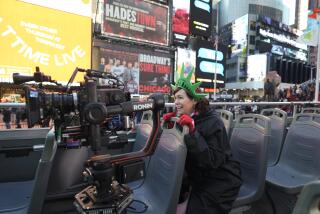THE HIDDEN HOLLYWOOD : Whether to Motivate or Indoctrinate, Corporate America Turns to Flash of Theatrical Production to Get Message Across
- Share via
The lights are as bright, the grease paint as pungent. But the roar of the crowd? Well, usually there isn’t one. In the world of corporate theater, results are more likely to be measured on the bottom line, not in critics’ columns or curtain calls.
Still, industrial entertainment, in all its myriad forms, is a lot like Broadway and Hollywood. So much so, that some have even referred to this souped-up form of business communication--which ranges from live theatrical events to training films to glossy slide shows--as the “hidden Hollywood.”
Industrial entertainment is exactly what its name implies. In the hands of an expert, what could be a potentially dreary, weighty--and, let’s face it, boring--industrial message is turned it into a lively, upbeat snippet of entertainment that allows the corporate doctrine to sink in before natural defenses come up.
The medium for the message varies.
The most common is a computer-synchronized, multiprojection slide show. Sometimes as many as 24 or 36 projections are beaming simultaneously on one or more screens. The net effect is a high-resolution movie being shown on a huge screen. Other forms include traditional “click-click” slide projections, live Ed Sullivan-like variety shows, interactive video training programs and complete, recreated “environments” in which participants take the role of the actors.
“When you target what it is you have to say with the medium you want to use, you have a very powerful way of reaching your audience,” said William Mauger, president of Sunbreak Productions, a small, 10-year-old Hollywood operation. “I like to ask: What is supposed to be different when this production is over? A sales increase? More employee productivity? Better corporate morale?”
Rap Song to Diffuse Anger
Take, for example, the message Citibank wanted to get out in 1985 to about 1,500 employees who were being moved for budget reasons from corporate headquarters on posh Park Avenue to Hell’s Kitchen, a Manhattan neighborhood not known for its elegance.
Not surprisingly, the workers were less than thrilled. Citibank turned to Yellowbrick Film Group in New York to diffuse the growing hostility.
Owner and director Peter Clayton said he decided to confront the anger head-on with a rap-style music video starring Carmine Bilardello, manager of the controversial project. Bilardello, described as “just nerdy enough to pull it off,” was given a shiny vinyl jacket, sunglasses and some finger-snapping lyrics extolling the virtues--including a nearby Macy’s department store--of Hell’s Kitchen.
Clayton won several industry awards for his seven-minute video, and, more importantly, Citibank, which is rumored to have spent about $115,000 on the show, believes that it took some of the sting, and stigma, out of the move.
There’s more to the industrial entertainment industry than feel-good rap videos designed to jive-talk the masses into compliance.
At the showiest end are multimillion-dollar, full-blown, theatrical productions, sometimes starring such big names as Bob Hope and Frank Sinatra, which major corporations annually toss for their employees, customers, clients and other members of their extended corporate families. Typically, the reasons are to thank the audience for past good work and to motivate them to do better in the future.
A few years ago, Avon tossed a 100th birthday party in five cities with a live, satellite-linked affair featuring Frank Sinatra singing a special version of “My Way,” a stunning touch for which Avon was willing to pay Sinatra’s personal fee of $250,000.
“Sinatra was the reward for the sales reps who had made that year the company’s best ever,” explained Paul Kielar, for the past 30 years the creative director of Jack Morton Productions, one of the largest business entertainment producers in the nation. “And those reps left that party really charged up about Avon.”
The supercharge was felt, too, on Avon’s bottom line. At the end of the hyperactive Christmas sales period, the company was able to retain an all-time high number of its independent sales representatives, giving it an important source of continued contact with customers in the following year.
Far less spectacular, but far more common to corporate America, are sales support shows, new product unveilings and employee-motivation specials. For the most part, these events, whose budgets typically range from $25,000 to $250,000, have become indispensable tools among large companies looking for ways to capture the attention and imagination of their employees, distributors and customers, and convert that enthusiasm into sales, increased productivity or corporate loyalty.
Auto makers, with their annual unveilings of new models, have traditionally been the bread and butter of industrial entertainment producers. But in recent years, food processing companies have used canned theatrics to introduce everything from a new formulation of tomato sauce to a new line of low-calorie desserts.
High technology has seized the medium, too. Apple Computer is believed to have spent well into seven figures on the show unveiling its new Macintosh computer in 1984. “There aren’t many companies willing to say ‘I want a good show and I don’t care what it costs,’ ” said Chris Korody, owner of Silver Strand Films in Manhattan, the producer of the Macintosh extravaganza. “Apple was a totally different company. It had a vision for how the lights and the entertainment could embellish its message.”
Another major segment of the industry encompasses employee training and communication, the how-to films and slide shows designed to teach new skills, sharpen old ones or pass on important corporate information quickly and often at a time or place convenient to the employee.
Some corporations put out their employee newsletters on video; others have video machines loaded with a corporate message running around the clock in a central gathering place, such as the cafeteria. Again, budgets for these videos, movies and slide shows vary greatly, but they generally receive lower budgets than their product and sales shows.
The entire industrial entertainment industry is estimated to have generated billings of about $13.5 billion in the United States last year, according to Vincent Hope, president of Hope Reports Inc., a Rochester, N.Y., newsletter tracking corporate communication trends. Of that amount, which does not include advertising, Hope estimates that $6 billion was spent to support internal corporate communication staffs and their activities; the remainder went to outside independent production services.
Corporate entertainment traces its roots to Detroit in the 1920s and, according to industry lore, owes its start to the national proliferation of auto dealerships requiring communication from Motown sales executives. Film proved to be just the right sales medium, and thus, industry old timers say, was born the first industrial film: a traveling commercial for new cars.
The industry remained largely an adjunct to auto and farm equipment sales operations until the advent of World War II. With the war came the immediate need for fast, efficient training of large numbers of soldiers in far-flung locations. The challenge was ideally suited to film, and the government underwrote the making of thousands of training, motivation and entertainment movies.
The government continued to support film making in the Cold War era of the 1950s with large scale spending for “audio-visual” classroom programs aimed at bringing American students up to par with their Sputnik-boasting Russian counterparts. Defense contractors learned from their mentors and adopted the medium to train assembly line workers and promote their huge aerospace contracts.
Spending on Shows Declines
Hope said that with only a few exceptions, corporate America did not catch on to the full potential of industrial theater until the late 1960s. And, he added, it was not until 1973 or so that corporate spending on audio-visual programs exceeded that of schools. Today, he says, about two-thirds of the industry spending comes from corporations--primarily the Fortune 1,000--with the remainder covered by educational institutions, government, health organizations and organized religions.
And despite an exploding interest in video technology and computerized graphics, Hope says spending on corporate communication and entertainment events has stagnated for the past two years and shows little sign of a quick rebound. At the heart of the reasons is the perceived expendability of corporate frills, such as parties.
“We have some clients who tell us not to make a show too glitzy because they don’t want employees to think they spent a lot on it,” said Bunny Yates, senior vice president of Amicus Communications, a Hollywood production company.
Another important reason is the increasing difficulty of capturing the imagination of an audience whose tastes and attention spans have been forever altered by the likes of rock videos, an exploding cable television menu and live-action, minicam television news reporting. “People today are visually jaded,” acknowledged Jack Morton Production’s Kielar. “We need to do more to reach today’s audience.”
And it’s not just the audiences. Yates said she finds herself selling against the expections created by television and its fancy computerized graphics and gee-whiz technology.
“Someone will come in and describe something they saw on TV the night before and then ask it we can give it to them for $40,000.”
More to Read
The biggest entertainment stories
Get our big stories about Hollywood, film, television, music, arts, culture and more right in your inbox as soon as they publish.
You may occasionally receive promotional content from the Los Angeles Times.










